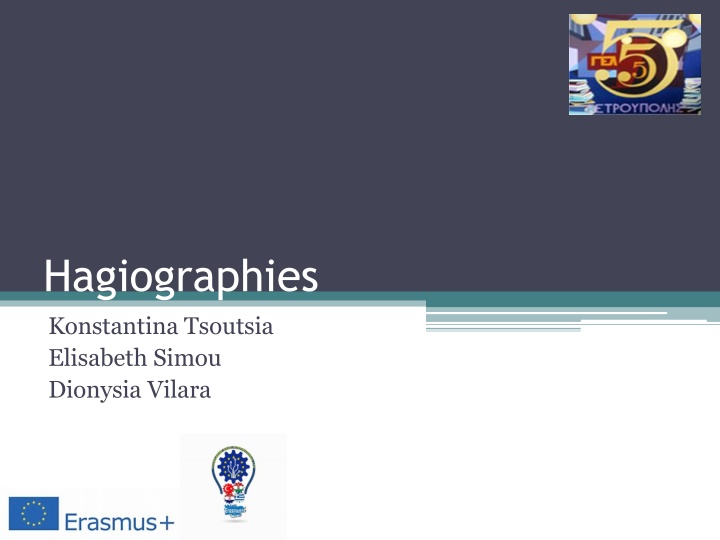Hagiographies
The art of hagiographies and icons in Eastern Christian tradition holds a significant historical and religious value. Icons depict religious figures such as Christ, Mary, saints, and angels in various artistic media like paintings, metal castings, stone carvings, and more. This tradition dates back to the early days of Christianity, with surviving images showing a continuity of style and subject despite periods of destruction like the Byzantine Iconoclasm. Explore the rich history and significance of hagiographies and icons in this insightful content.
Download Presentation

Please find below an Image/Link to download the presentation.
The content on the website is provided AS IS for your information and personal use only. It may not be sold, licensed, or shared on other websites without obtaining consent from the author.If you encounter any issues during the download, it is possible that the publisher has removed the file from their server.
You are allowed to download the files provided on this website for personal or commercial use, subject to the condition that they are used lawfully. All files are the property of their respective owners.
The content on the website is provided AS IS for your information and personal use only. It may not be sold, licensed, or shared on other websites without obtaining consent from the author.
E N D
Presentation Transcript
Hagiographies Konstantina Tsoutsia Elisabeth Simou Dionysia Vilara
An icon is a religious work of art, most commonly a painting.The most common subjects include Christ, Mary, saints and angels. Although especially associated with "portrait" style images concentrating on one or two main figures, the term also covers most religious images in a variety of artistic media produced by Eastern Christionity , including narrative scenes. Icons can represent various scenes in the Bible. Saint Elisabeth
The Ladder of Divine Ascent icon showing monks ascending to Jesus in Heaven, top right. 12th century, Saint Catherine's Monastery Icons may also be cast in metal, carved in stone, embroidered on cloth, painted on wood, done in mosaic or fresco work, printed on paper or metal, etc. Comparable images from Western Christianity are generally not classified as "icons", although "iconic" may be used[by whom?] to describe a static style of devotional image.
Eastern Orthodox tradition holds that the production of Christian images dates back to the very early days of Christianity, and that it has been a continuous tradition since then. Modern academic art history considers that, while images may have existed earlier, the tradition can be traced back only as far as the 3rd century, and that the images which survive from Early Christian art often differ greatly from later ones. The icon of St Nicolas carved in stone. Between the 12 and 15th cc. Radomysl Castle, Ukraine[1]
The icons of later centuries can be linked, often closely, to images from the 5th century onwards, though very few of these survive. Widespread destruction of images occurred during the Byzantine Iconoclasm of 726 842, although this did settle permanently the question of the appropriateness of images. Since then icons have had a great continuity of style and subject; far greater than in the images of the Western church. At the same time there has been change and development. St Peter encaustic on panel, c. 6th century (Saint Catherine's Monastery).
THE END THANKS FOR YOUR ATTENTION

